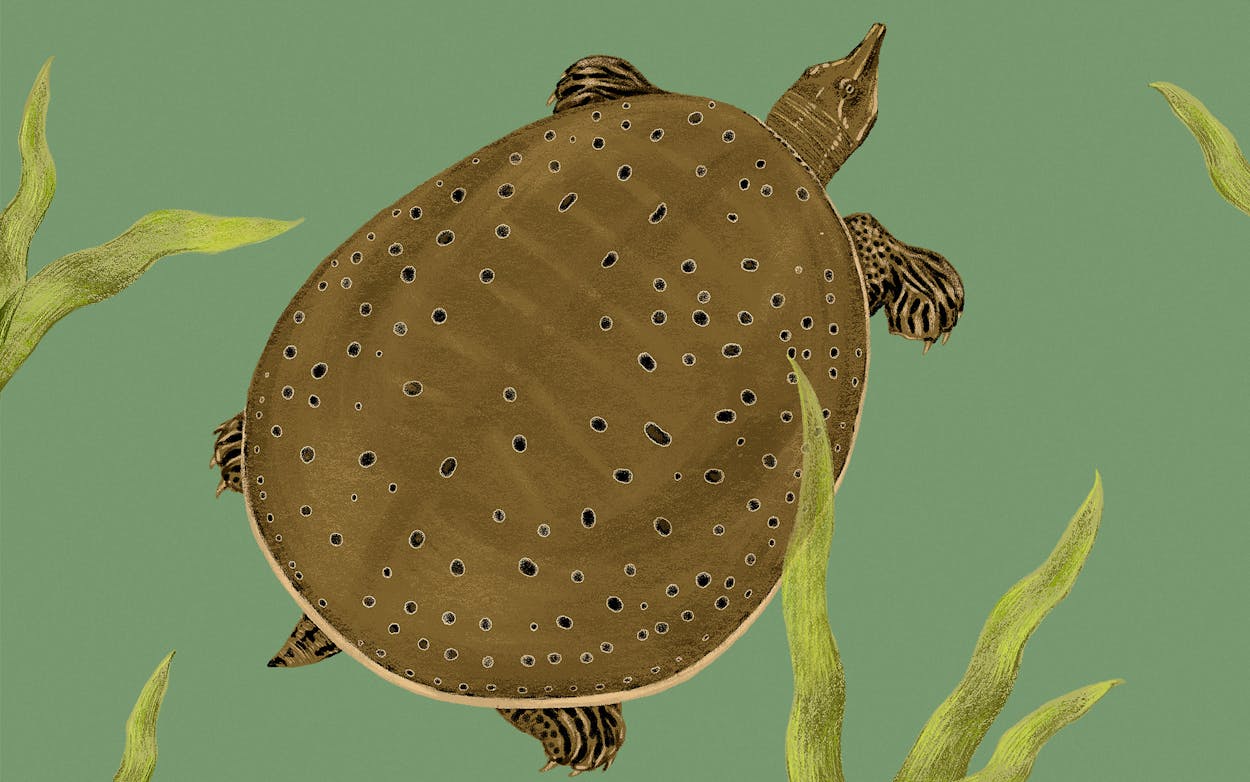Latin name: Apalone spinifera
Size: As long as 21 inches (female) or 9 inches (male)
Habitat: Anywhere wet, especially rivers
The creature paddling leisurely in the gin-clear water at Balmorhea State Park, in far West Texas, was the approximate size, shape, and color of a buttermilk flapjack. When I crouched along the grassy banks of a small ciénaga, or desert wetland, near the park’s lodge, the turtle raised its long, wrinkly neck and stared at me. I couldn’t help but smile.
Spiny softshell turtles are delightfully strange. Their snorkel-like snout, pinprick eyes, and fat feet appear to be borrowed from a fantastical anime character. The Texas spiny softshell (illustrated above) that resides in the Pecos and Rio Grande river systems is one of four subspecies in the state. I’ve also been charmed by the Guadalupe spiny softshell, which is found in Central and South Texas.
What’s up with that soft shell?
Glad you asked. The term is misleading, because softshell turtles do have a firm covering; it’s just a bit softer and flatter than most turtles’ and has skin on top, giving it a leathery feel. The aerodynamic shape also helps them get around—they are the fastest-swimming turtles in the state. They can stay underwater for hours, absorbing oxygen through their skin and the lining around their throat and anal areas.
Does it bite?
Most definitely. “They’re no-nonsense turtles . . . and they can deliver a painful and memorable bite,” says Carl J. Franklin, a Grand Prairie–based herpetologist and president of the nonprofit group Texas Turtles. Females can be especially aggressive. Franklin once watched about nine lady spiny softshells duke it out over one gent. “Softshells are also the only kind of turtle known to be accused of biting a penis off someone,” Franklin adds cheerfully. That incident is believed to have happened in China, in 2016, and the softshell wasn’t a species that lives in Texas, but still—best to watch from a distance.
What does it eat?
Pretty much any animal that will fit into its mouth, such as crawfish, insects, and small fish. And speaking of food, softshell turtle meat is considered a delicacy. In 2018 Texas Parks and Wildlife issued a total ban on commercial hunting of the spiny softshell and three other turtle species. Today the reptiles are thriving across the state’s rivers, lakes, and bayous.
How long does it live?
As long as 25 years in captivity and likely a little less in the wild. That’s a pretty good run for a turtle. The softshell’s sturdy, solid body shape may have something to do with that. “They’re built like flying saucers, and they move through the water like F16s,” Franklin says. He once found a softshell that had survived what appeared to be an attack from a larger, even tougher alligator snapping turtle. Despite losing a leg and suffering extensive damage to its skin and muscles, the creature healed on its own and lived to fight another day.
This article originally appeared in the October 2023 issue of Texas Monthly with the headline “Spiny Softshell Turtle.” Subscribe today.









